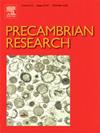Evolving marine sedimentation, redox stratification, and biogeochemical cycling in mid- to low-latitudinal non-frozen waters during late Neoproterozoic global-scale climatic transitions
IF 3.2
2区 地球科学
Q2 GEOSCIENCES, MULTIDISCIPLINARY
引用次数: 0
Abstract
Indian Neoproterozoic successions offer unique insights into global paleoclimatic and biogeochemical transitions. This study presents a detailed sedimentological and geochemical analysis of marine siliciclastic sedimentary rocks from the Cave-Temple Arenite Member of the Kerur Formation, the lowermost formation of the Badami Basin within the Dharwar Craton of the South Indian Shield. Geochronological constraints on overlying carbonate rocks from the Konkankoppa Limestone Member of the uppermost Katageri Formation provide a post-Cryogenian to mid-Ediacaran age of 604 ± 25 (1σ) Ma for the upper limit of marine sedimentation. Sedimentological and geochemical proxies, accompanied with previous geochronological and provenance studies, indicate a rift-related intracratonic basin influenced by tectonic processes associated with the Rodinia supercontinent breakup. Provenance studies reveal sediment contributions predominantly from the Archaean to Mesoproterozoic quartzofeldspathic sources. Marine intervals exhibit distinct stratification, with oxic, brackish to mildly saline shallow waters transitioning to anoxic-euxinic, more saline deeper waters. These conditions emerged above a fluvio-alluvial cycle formed during cold, arid climatic conditions. However, CIA (Chemical Index of Alteration) values suggest subsequent warmer, humid climates during the transgression and evolution of the marine interval. This scenario of climate change and marine transgression likely reflects a global climatic shift during one of the two potential hothouse phases, depending on the estimated minimum and maximum depositional ages spanning approximately from 629 to 579 Ma. These ages correspond either to the post-Marinoan or the post-Gaskiers glaciations, both characterized by intense chemical weathering, high nutrient influx, and enhanced productivity along deeper marine shelves. The studied succession, marked by the absence of glacial deposits and a stratified non-frozen marine setting supposedly situated at mid- to low latitudes, offers evidence for a unique paleoenvironment that harboured active biogeochemical cycles amidst evolving climatic conditions.
新元古代晚期全球尺度气候变迁中中低纬非冻结水域的海洋沉积、氧化还原分层和生物地球化学循环
印度新元古代序列为全球古气候和生物地球化学转变提供了独特的见解。本文对南印度盾构Dharwar克拉通内巴达米盆地最下层Kerur组的洞穴-庙宇Arenite段海相硅质沉积岩进行了详细的沉积学和地球化学分析。对上覆的Katageri组Konkankoppa灰岩段碳酸盐岩的年代学约束表明,海相沉积的年龄上限为604±25 (1σ) Ma。沉积学和地球化学指标,结合以往的年代学和物源研究表明,罗迪尼亚超大陆分裂相关的构造过程影响了与裂谷相关的克拉通内盆地。物源研究表明,沉积贡献主要来自太古宙至中元古代的石英岩源。海洋间隔表现出明显的分层,由缺氧,半咸水到轻度咸水的浅水过渡到缺氧-缺氧,咸水较多的深水。这些条件出现在寒冷干旱气候条件下形成的河流-冲积循环之上。然而,CIA(化学蚀变指数)值表明,在海侵和海相间隙演化过程中,随后的气候变暖、湿润。这种气候变化和海侵情景可能反映了两个潜在温室期之一的全球气候变化,这取决于估计的最小和最大沉积年龄,大约为629至579 Ma。这些时代对应于后马里诺冰期或后盖斯基冰期,两者的特征都是强烈的化学风化,高营养物质流入,以及沿着更深的海洋大陆架的生产力提高。研究的演替,以没有冰川沉积和假定位于中低纬度的分层非冻结海洋环境为标志,为在不断变化的气候条件下拥有活跃的生物地球化学循环的独特古环境提供了证据。
本文章由计算机程序翻译,如有差异,请以英文原文为准。
求助全文
约1分钟内获得全文
求助全文
来源期刊

Precambrian Research
地学-地球科学综合
CiteScore
7.20
自引率
28.90%
发文量
325
审稿时长
12 months
期刊介绍:
Precambrian Research publishes studies on all aspects of the early stages of the composition, structure and evolution of the Earth and its planetary neighbours. With a focus on process-oriented and comparative studies, it covers, but is not restricted to, subjects such as:
(1) Chemical, biological, biochemical and cosmochemical evolution; the origin of life; the evolution of the oceans and atmosphere; the early fossil record; palaeobiology;
(2) Geochronology and isotope and elemental geochemistry;
(3) Precambrian mineral deposits;
(4) Geophysical aspects of the early Earth and Precambrian terrains;
(5) Nature, formation and evolution of the Precambrian lithosphere and mantle including magmatic, depositional, metamorphic and tectonic processes.
In addition, the editors particularly welcome integrated process-oriented studies that involve a combination of the above fields and comparative studies that demonstrate the effect of Precambrian evolution on Phanerozoic earth system processes.
Regional and localised studies of Precambrian phenomena are considered appropriate only when the detail and quality allow illustration of a wider process, or when significant gaps in basic knowledge of a particular area can be filled.
 求助内容:
求助内容: 应助结果提醒方式:
应助结果提醒方式:


